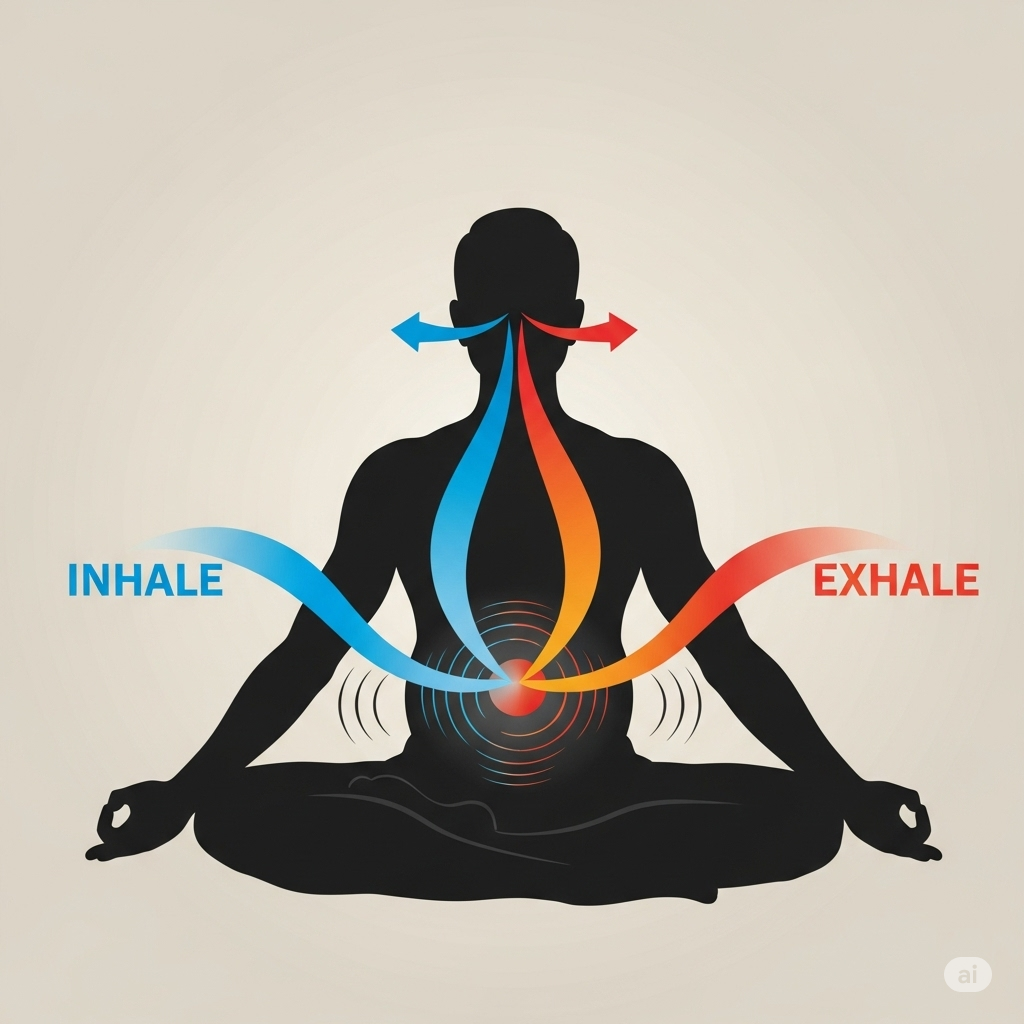School of Yoga explains nāḍī-śuddhi-prāṇāyāma or anulom-vilom
Nāḍī-śuddhi is a basic and most widely used form of prāṇāyāma and means nāḍī = energy channel + śuddhi = cleanser. Anulom-vilom, which means inhalation-exhalation, is another name for this technique.
How to perform nāḍī-śuddhi in easy steps?
- First, sit comfortably in padmāsana, sukhāsana or vajrāsana. Also, keep the back erect.
- Next, place thumb over right nostril and ring finger + little finger over left nostril. Then, turn the other 2 fingers turned into the palm.
- Lastly, close the right nostril with your thumb and inhale through the left nostril for 4 counts.
- Thereafter, close both nostrils and hold your breath for 6 counts.
- Now, release the ring finger from over the left nostril & exhale through the left nostril for 6 counts, increasing to 8 counts as your capability increases.
- Again, close both nostrils & hold your breath for 6 counts.
- After this, repeat using the reverse method.
- Breathe in through the right nostril for 4 counts, close both nostrils for 6 counts, open the left nostril, and breathe out for 6 counts.
- This is a round of nāḍī-śuddhi.
- Importantly, repeat the cycle 5 times. Rest between cycles if required.
- Additionally, try to slowly increase to 20 rounds.
- Lastly, slowly try increasing the duration of inhalation (puraka), holding (kumbaka), and exhalation (rechaka) as you gain confidence.
Over time, you could also increase the ratio of inhalation, holding, and exhalation to your comfort. Only, ensure that exhalation is close to twice of inhalation so that lung volumetric efficiency is increased. Also, ensure that the breathing is calm and steady, not erratic, agitated, or jerky.
What are the benefits of nāḍī-śuddhi prāṇāyāma?
- Since the breathing process is measured and steady, the forced volume capacity of the lung increases over time and with practice.
- Consequently, the evacuation of waste gases (CO2 and water vapour) is increased.
- As a result, the transfer capacity of the lungs gets improved. Importantly, transfer capacity is the amount of oxygen that enters the body and the amount of CO2 + water vapour that gets removed from the body.
- Furthermore, the above practice increases oxygen content in the bloodstream while removing toxins. This helps improve health and immunity.
- Nāḍī-śuddhi prāṇāyāma also improves left/ right brain activity equalization.
- Lastly, the practice of steady breathing reduces stress, and purges excess adrenalin and related toxins from the system.
Let us learn about the variants of nāḍī-śuddhi prāṇāyāma.
The surya-bheda (splitting the sun) variant of nāḍī-śuddhi prāṇāyāma
This is a variation of nāḍī-śuddhi-prāṇāyāma. In nāḍī-śuddhi, the inhalation and exhalation are alternated between the left and right nostrils. However, in surya-bheda-prāṇāyāma, all inhalation is only performed using the right nostril, while the exhalation is performed using the left nostril.
Sūrya-bheda technique explained in easy steps.
- First, sit comfortably in padmāsana, sukhāsana or vajrāsana. Keep your back erect.
- Next, close the left nostril with your thumb and inhale through the right nostril for 4 counts.
- After this, close both nostrils and hold your breath for 6 counts.
- Release the ring finger from over the left nostril & exhale to 6 counts, increasing to 8 counts as you become confident.
- Finally, close both nostrils & hold your breath for 4 counts.
- Lastly, breathe normally, and relax.
- This is a round of sūrya-bheda-prāṇāyāma which activates piṅgalā-nāḍī.
- Repeat by starting again with inhalation through the right nostril, hold, exhalation through the left nostril, hold.
- Additionally, practice 5 rounds.
- Lastly, rest in between if required.
The Chandra-bheda (splitting the moon) variant of nāḍī-śuddhi prāṇāyāma
In nāḍī-śuddhi, the inhalation and exhalation are alternated between the left and right nostrils. However, in chandra-bheda-prāṇāyāma, all the inhalation is only performed using the left nostril while the exhalation is performed using the right nostril. This process is the opposite of sūrya-bheda-prāṇāyāma.
Chandra-bheda prāṇāyāma technique explained in easy steps.
- First, sit comfortably in padmāsana, sukhāsana or vajrāsana. Keep your back erect.
- Next, close the right nostril with your thumb and inhale through the left nostril for 4 counts.
- After this, close both nostrils for 4 counts & hold your breath.
- Closing ring finger from over left nostril & exhale through the right nostril to 6 counts, increasing to 8 counts as you become confident.
- Finally, close both the nostrils & hold your breath for 6 counts.
- Lastly, breathe normally, and relax.
- This is a round of chandra-bheda-prāṇāyāma activates the idā-nāḍī.
- Repeat by starting again with inhalation through the left nostril, hold, exhalation through the right nostril, hold.
- Additionally, practice 5 rounds.
- Lastly, rest in between if required.
After a round of sūrya-bheda and chandra-bheda-prāṇāyāma, perform nāḍī-śuddhi to re-balance the flow of prāṇa in the body.
The Hatha Yoga Pradeepika on nāḍī-śuddhi: Chapter 2, verses 7 to 10.
- Sitting in padmāsana, the yogi inhales through the Moon nostril (idā or left nostril). Then, retaining it to one’s ability, he exhales through the Sun (piṅgalā or right nostril).
- Then, drawing in air through the Sun nostril (right nostril), the belly should be filled. After performing kumbhaka as before, the air should be exhaled through the idā.
- Inhaling thus, through the same nostril through which air was expelled, and having retained it to the utmost, it should be exhaled through the other, slowly, not fast.
- If one inhales the air through the idā, it should be expelled through the piṅgalā. If air is drawn in through the piṅgalā and retained there, it should be expelled through the idā.
- Those that practice thus through the Sun and Moon should have clean nādis after 3 months or so.
Points to ponder on nāḍī-śuddhi.
Internal Links: Dharma (conditioning), Stress and Situational Awareness, Prana, Asana overview 1, Asana Overview 2, Asana Focus or gazing, Hatha Yoga Pradeepika
External Links: Prana, Chakra, Pancha Tattva, Pancha Prana, Pancha Kosha, Nadi, respiration
- What are the variations of nāḍī-śuddhi-prāṇāyāma?
- Importantly, which techniques of prāṇāyāma impact stress situations most?
- What are the various techniques to enhance prāṇāyāma capability?
- Long-term effects of nāḍī-śuddhi-prāṇāyāma … discuss…
- Prāṇāyāma sitting postures… advantages and disadvantages?
- What is the right time to do prāṇāyāma?
- Prāṇāyāma and its impact on situational awareness (prajñā).


